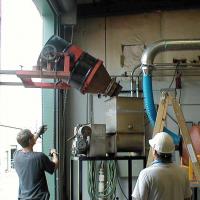Waste Characterization for Remediation
Changing regulatory requirements drive the development of innovative technologies for cleaning up existing sites and treating wastes being generated, while minimizing future waste production. Hazen recognizes that successful treatment technologies must also be economically favorable.
We investigate and develop processing technologies for the remediation and recycling of waste materials. The critical first step in treatment technology development is waste characterization. Proper characterization of a waste includes determining both the chemical and physical properties of the material. To characterize a waste, Hazen follows standard analytical procedures, including those published by EPA and ASTM, for evaluating hazardous or nonhazardous waste materials. Waste characterization procedures identify important process baseline information that will be needed in the selection of the appropriate remediation methods. These methods may include, for example, any combination of technologies such as high- and low-temperature thermal treatment, chemical leaching, soil washing, and physical separations, waste stabilization, and bioremediation. Another important aspect of waste characterization studies is the valuable information that is provided prior to pilot testing of potential or selected remediation treatment technologies, particularly the associated and critical materials-handling requirements.
During pilot plant testing, materials-handling problems are identified, then solutions to these problems are developed and demonstrated while the process flow sheet is being evaluated. This information is essential for designing a waste remediation process that is both efficient and economical at the commercial level. Hazen's waste characterization capabilities are listed below. These procedures apply to both hazardous and nonhazardous wastes and cover a wide range of measurements necessary for developing the design of a remediation process.
Characterization Procedures for Waste Materials
Physical Characterization Methods
- Moisture Content
- Ash Content
- Particle Size Distribution
- Bulk Density
- Atterburg Limit
- Proctor Compaction Test
- Microparticle Size Analysis
- pH
- Specific Gravity
- Electrostatic and Magnetic Properties
Chemical Characterization Methods
- Ultimate, Proximate, and Heating Value Analyses
- Forms of Sulfur (Total, Sulfate, Sulfite)
- Forms of Carbon (Total, Carbonate, Organic)
- Cation Exchange Capacity
- Halogens (Fluorine, Chlorine, Bromine)
- Wet Chemical Sequential Extraction
- Hazardous Substance List (HSL) Metals Analysis
- Organics (Volatiles, Semivolatiles, Pesticides, PCBs, etc. by appropriate EPA method)
- TCLP (Metals and Organics)
- Generalized Acid Neutralization Capacity (Acetic Acid)
- Reversed Generalized Acid Neutralization Capacity (Sodium Hydroxide)
- Cyanide and Sulfide Reactivity
- X-ray Fluorescence Metals Analysis
- Thermogravimetric Analysis
Dry Solid or Ash Characterization Methods
- TCLP Metals
- TCLP Plus 25 Organics and 8 Herbicides/Pesticides
- Optical Microscope, X-ray Diffraction, Electron Microprobe, and Scanning Electron Microscope Analyses for Mineral and Compound Identification
- Hazardous Substance List (HSL) Metals Analysis
- Elemental Ash Analysis
- Differential Thermal Analysis
- Ash Fusion Temperature

Service Applications
Related Capabilities
Contact Hazen
Main (303) 279 4501
Fax (303) 278 1528
E-mail / Directions
Submit RFP
